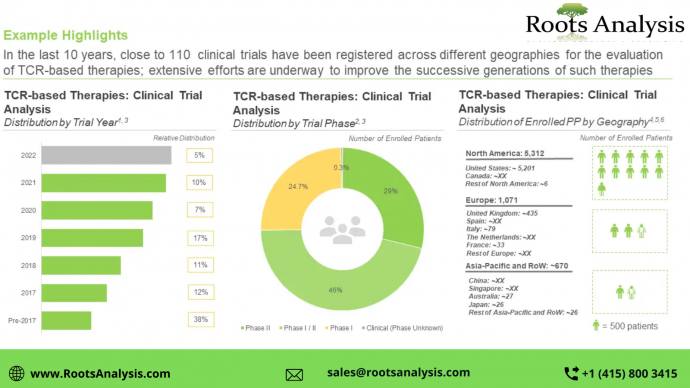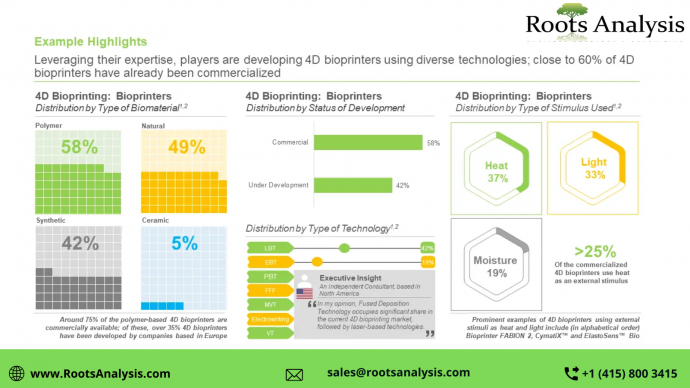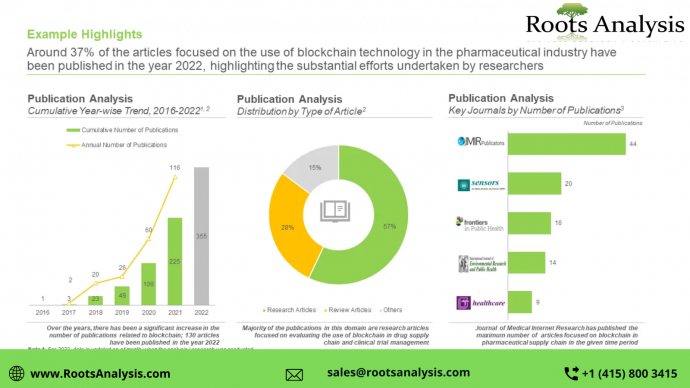
berry cristan
16 февраля 2023
TCR Therapies: An Emerging Therapeutic Modality
Structurally, TCR is a heterodimer comprising of two different polypeptide chains, namely the α-chain and β-chain.
Modified T-cell receptors or TCR therapies is an emerging class of adoptive therapy that employs genetically modified lymphocytes to target specific tumor markers. TCR therapies tumor-cell killing efficacy may be primarily attributed to the fact that they are pre-sensitized to cancer specific antigens; this enables such interventions to selectively target and eliminate tumor cells from the body of a host with negligible treatment-related side effects.
Ongoing and planned clinical research initiatives in this direction are driven by encouraging results achieved in past trials, which were mostly focused on various hematological cancers and solid tumors. Driven by the ongoing pace of innovation in this field, sufficient financial support from investors and encouraging clinical trial results, this market is likely to witness significant growth in the foreseen future.
Current Market Landscape of TCR-based Therapies
The landscape features, close to 60 industry players, across the globe claim to be engaged in the development and clinical evaluation of antigen sensitized TCR-based cell therapies. The contemporary TCR-based therapies market is characterized by a healthy and growing pipeline of more than 190 candidate therapies. Kimmtrak® is the first TCR-based therapeutic to reach in market. Further, some of the therapies which are able to reach advanced stages, includes GSK3377794 (GlaxoSmithKline), NY-ESO-1 TCR (Jonsson Comprehensive Cancer Center) and ADP-A2M4 (Adaptimmune Therapeutics), are in the of development.
Driven by the availability of innovative technology platforms, lucrative funding and encouraging clinical trial results, the market for these therapies is poised to grow in the long-run, as multiple product candidates are expected to receive marketing approval in the coming decade.
Rising Interest in TCR-based Therapies
The growing interest in this field is reflected in the notable increase in partnerships inked (close to 140 deals inked in the past decade; CAGR 23%) by several industry players and academic / research institutes. Additionally, various investors, having realized the opportunity within this upcoming segment of T-cell immunotherapy, have invested USD 11 billion across 140 instances, since 2007. Further, in the last 10 years, close to 110 clinical trials have been registered across different geographies for the evaluation of TCR-based therapies. Mostly driven by the need for effective treatment options for cancer, the TCR-based therapy pipeline is expected to steadily grow over the coming years.
For additional details, please visit
https://www.rootsanalysis.com/blog/tcr-therapies-market/ or email sales@rootsanalysis.com
You may also be interested in the following titles:
1. Smart Labels Market: Industry Trends and Global Forecasts, 2022-2035
2. AI-based Digital Pathology / AI Pathology Market: Industry Trends and Global Forecasts, 2022-2035
About Roots Analysis
Roots Analysis is a global leader in the pharma / biotech market research. Having worked with over 750 clients worldwide, including Fortune 500 companies, start-ups, academia, venture capitalists and strategic investors for more than a decade, we offer a highly analytical / data-driven perspective to a network of over 450,000 senior industry stakeholders looking for credible market insights.
Contact:
Ben Johnson
+1 (415) 800 3415
Ben.johnson@rootsanalysis.com


15 февраля 2023
Cell Therapy – The Revolutionary Therapeutic Modality: All Set to Obliterate Oncological Disorders
The American Society of Gene and Cell Therapy (ASGCT) defines cell therapy as a therapeutic modality that involves the administration of either normal or modified cells to patients for the treatment of various diseases.
In this form of therapy, patients are injected with living and intact human cells that are deemed to be capable of providing therapeutic benefit. It is worth mentioning that such transplanted cells have been shown to restore or repair the cells that are damaged or have ceased functioning due to diseased condition. The main goal of cell therapy is to target the root cause of the disease at a cellular level. It is also worth highlighting that there are a significant number of cell therapies that are currently under clinical development.
Cell Therapy Manufacturers – Current Market Landscape
The current market landscape features the presence of over 240 CDMOs and in-house players that are engaged in the manufacturing of cell therapies, across various scales of operation
The Increasing Interest in this Field is also Reflected in Recent Partnership Activity
The number of partnerships inked in this domain demonstrates the growing interest of players in the cell therapy manufacturing market; majority of the deals have been done for the clinical manufacturing of T cell therapies
Big Pharma Initiatives: Indicative of the Increasing Interest among Established Players
Around 50% of the big pharma initiatives have been undertaken for the purpose of expanding their portfolio and capabilities through partnerships and collaborations; of these, 70% initiatives were undertaken post 2019
Future Evolution of Cell Therapy Manufacturing Market
The global cell therapy manufacturing market is expected to grow at a CAGR of 12%, till 2035; T cell therapies and stem cell therapies capture more than 85% of the current market share
Conclusion
More than 1,000 cell and gene therapy candidates are currently being investigated for the treatment of a myriad of disease indications. In order to ensure the continued success of these novel therapies, there are several ongoing efforts to address the complexities related to their development and manufacturing. In recent years, several big pharma players have also undertaken initiatives, including establishing strategic partnerships with other industry players and carrying out expansion projects, in order to enhance their cell therapy manufacturing capabilities. Considering the ongoing efforts of stakeholders to mitigate the manufacturing associated complications and an enhanced emphasis on the advancement of such therapies, the cellular therapy manufacturing market is anticipated to witness significant growth in the foreseen future.
For additional details, please visit
https://www.rootsanalysis.com/blog/the-revolutionary-therapeutic-modality-cell-therapy/ or email sales@rootsanalysis.com
You may also be interested in the following titles:
1. Smart Labels Market: Industry Trends and Global Forecasts, 2022-2035
2. AI-based Digital Pathology / AI Pathology Market: Industry Trends and Global Forecasts, 2022-2035
About Roots Analysis
Roots Analysis is a global leader in the pharma / biotech market research. Having worked with over 750 clients worldwide, including Fortune 500 companies, start-ups, academia, venture capitalists and strategic investors for more than a decade, we offer a highly analytical / data-driven perspective to a network of over 450,000 senior industry stakeholders looking for credible market insights.
Contact:
Ben Johnson
+1 (415) 800 3415
Ben.johnson@rootsanalysis.com


14 февраля 2023
4D Bioprinting Market: Key Trends
4D bioprinting refers to the addition of a fourth dimension that enables 3D printed structures to change their shape with time with the help of smart biomaterials, which have the tendency to morph in the presence of stimuli (such as, heat, light, electricity, magnetic energy, stress).
Various industry stakeholders and academicians have undertaken several initiatives to further develop / improve this technology for a variety of applications.
Why not opt for 3D bioprinting?
The application area of 3D bioprinting includes the printing of living cells and enables the development of highly complex tissues that mimic the structure and performance ability of desired organ, within the body. Although 3D bioprinting results in the printing of an exact replica of primary human organs, however, the printed 3D objects are inert and static in nature and are unable to change shape when subjected to environmental changes. 4D bioprinting makes this possible as the incorporation of a fourth dimension enables these structures to change their shape with time.
Current Market for 4D Bio-printing and Smart Biomaterial Developers
~60 4D Bioprinter and Smart Biomaterial Developers
North America Leading the Pack
Close to 50% of 4D bioprinter and smart biomaterial developers are headquartered in North America. Of these, around 60% of these players are well established players
Almost 130% annual growth observed in publications since 2016
Number of Publications in this domain has been growing at a steady rate. Over 50% of the total publications have been published in the year 2021.
Current Demand for is likely to Grow at a CAGR of 34%
Currently, highest demand is for 4D bioprinting technology is by academic research and development. Moreover, 45% of the market for 4D bio-printing is generated in the North America region.
For additional details, please visit https://www.rootsanalysis.com/blog/4d-bioprinting-key-trends/ or email sales@rootsanalysis.com
You may also be interested in the following titles:
1. Smart Labels Market: Industry Trends and Global Forecasts, 2022-2035
2. AI-based Digital Pathology / AI Pathology Market: Industry Trends and Global Forecasts, 2022-2035
About Roots Analysis
Roots Analysis is a global leader in the pharma / biotech market research. Having worked with over 750 clients worldwide, including Fortune 500 companies, start-ups, academia, venture capitalists and strategic investors for more than a decade, we offer a highly analytical / data-driven perspective to a network of over 450,000 senior industry stakeholders looking for credible market insights.
Contact:
Ben Johnson
+1 (415) 800 3415
Ben.johnson@rootsanalysis.com


13 февраля 2023
Applications of Blockchain in Various Sectors
The term blockchain refers to the way it stores transaction data in blocks that are linked to form a chain. Since every entry is stored as a block on the chain, the length of the chain increases as more transactions are recorded and stored.
The digital ledger technology was developed in 2008 by Satoshi Nakamoto. Since then, it has proven to be a versatile tool with various applications of for decentralized monetary transactions and data exchange in various industries, such as banking, cyber security, supply chain management, government, and healthcare as it essentially acts as distributed ledgers that record transactions on a common digital platform.
Several stakeholders in healthcare have adopted blockchain for various operations, including maintenance of patient records, while ensuring privacy and security as the records are stored on a network, recruiting patients for trials, and providing transparency and traceability in the supply chain.
Types of Blockchain Technology
It is considered to be one of the most remarkable technological conceptions till date, however, the field is unexplored, and the current extent of application is still regarded as beginning of the forthcoming revolution. Depending on the level of intelligence embedded into a system, (in terms of versatility and performance), it can be classified into multiple types:
Permissionless or Public Blockchain: A public block chain, also referred to as permission-less network, is completely decentralized block chain network where anyone can participate without restrictions.
Permissioned or Private Blockchain: A block chain network that works in a closed network or that is under the control of a single entity, is a private block chain.
Federated or Consortium Blockchain: In a consortium block chain, preset nodes control the consensus processes. It has a validator node that performs transaction initiation, reception, and validation.
Applications of Blockchain Technology
This technology has emerged as a viable option to store / exchange data within various industries by providing end-to-end visibility, streamlining processes, and resolving issues faster.
Energy Management: Block chain allows companies involved in energy management to track energy consumption in a more accurate and efficient manner, by monetizing the data collected on such platforms and validating energy consumption and savings in real-time.
Government: Block chain has demonstrated the potential to help government agencies create / maintain a confidential framework of linked data records obtained from patients. This method is presumed to enhance the security, transparency, and efficiency of government operations, while eliminating the risks associated with corrupt practices.
Education: Block chain-based systems can serve as a notary for maintaining educational records in schools / other educational institutes.
Insurance: The blockchain technology is transforming insurance-related processes by speeding up the verification and validation of data.
Healthcare: Blockchain technology provides a faster solution for tracking and authenticating medical shipments / drugs across the supply chain. In addition, clinical trial data can be shared securely over blockchain-enabled platforms / portals.
Banking and Payments: Blockchain has enabled a faster and relatively cheaper way of transferring money in the banking sector.
Real Estate: Block chain enables tracking, transferring property deeds, verifying ownership, ensuring accuracy of documents, and speeding up real-estate related transactions.
Legal: Using the block chain technology, legal documents can be verified, stored, and retrieved securely.
Cybersecurity: The complex structure of a blockchain network is instrumental in protecting stored data from hackers, thereby, eliminating any possibility of security of such information being compromised.
Pharmaceutical: Using blockchain, every action of the supply chain for pharmaceutical products can be tracked, assisting to prevent counterfeiting and enabling manufacturers to locate a recalled product in seconds.
Advantages and Limitations of Blockchain
Despite the growing interest of stakeholders across various applications of blockchain, it is associated with several challenges, including scalability issues, lack of security and cyber-attacks. In order to deal with the aforementioned challenges, organizations have established transparency and privacy to conceal sensitive patient data while allowing access, only when required.
Future Perspectives
In the last decade, the popularity of blockchain technology has invariably grown. Specifically, it has made a considerable impact in the healthcare and financial sectors. Blockchain has the potential to revolutionize the healthcare sector by overcoming the existing challenges. One of the features of blockchain is that it lets organizations establish transparency and privacy, helping to conceal sensitive patient data while enabling access and sharing when necessary. In the future, blockchain technology may aid in the provision of personalized, authentic, and reliable clinical trial services by combining up-to-date and secure patient data with other emerging technologies. Considering the fact that blockchain technology is already employed in healthcare and various other industries, additional efforts and initiatives will allow the industries to leverage the full potential of blockchain technology.
For additional details, please visit
https://www.rootsanalysis.com/blog/applications-of-blockchain/ or email sales@rootsanalysis.com
You may also be interested in the following titles:
1. Smart Labels Market: Industry Trends and Global Forecasts, 2022-2035
2. AI-based Digital Pathology / AI Pathology Market: Industry Trends and Global Forecasts, 2022-2035
About Roots Analysis
Roots Analysis is a global leader in the pharma / biotech market research. Having worked with over 750 clients worldwide, including Fortune 500 companies, start-ups, academia, venture capitalists and strategic investors for more than a decade, we offer a highly analytical / data-driven perspective to a network of over 450,000 senior industry stakeholders looking for credible market insights.
Contact:
Ben Johnson
+1 (415) 800 3415
Ben.johnson@rootsanalysis.com


10 февраля 2023
Monkeypox: Disease Overview, Transmission and Diagnosis
Monkeypox is a viral disease, which is usually transmitted to humans from animals. The disease is known to have symptoms similar to those observed in smallpox patients, although it is considered to be clinically less severe.
In recent years, monkey pox has emerged as a prominent orthopox virus affecting public health. In May 2022, multiple cases of the disease were reported in more than 100 non-endemic countries, thereby making monkeypox a disease of global concern. Consequently, in July 2022, the World Health Organization (WHO) declared global monkey pox outbreak a Public Health Emergency of International Concern (PHEIC). In fact, till date, over 84,000 cases of the disease have been reported, globally.
Monkeypox infection can be divided into two periods:
1. Invasion Period (0 to 5 days): This phase is characterized by fever, intense headache, lymphadenopathy (swelling of the lymph nodes), back pain, myalgia (muscle aches) and intense asthenia (lack of energy)
2. Skin Eruption (begins within 1 to 3 days of appearance of fever): Monkeypox rash affects the face (in 95% of cases), palms of the hands and soles of the feet (in 75% of cases). Oral mucous membranes (in 70% of cases), genitalia (30%), and conjunctivae (20%), as well as the cornea are also affected.
Monkeypox Disease Transmission
Monkeypox virus can be transmitted from animals to humans as well as from humans to humans.
Animals to Humans Transmission:
Zootnotic transmission can occur from direct contact with the bodily fluids, blood or cutaneous / mucosal lesions of infected animals. Additionally, eating inadequately cooked meat and other animal products of infected animals is a possible risk factor.
Humans to Humans Transmission:
Human-to-human transmission can result from close contact with respiratory secretions, skin lesions of an infected person or recently contaminated objects. Transmission can also occur via the placenta from mother to fetus or during close contact during and after birth.
Monkeypox Disease Diagnosis
Polymerase chain reaction (PCR) is the preferred laboratory test for monkey pox virus detection due to its accuracy and sensitivity. Optimal diagnostic samples for monkey pox diagnosis are collected from skin lesions; these include roof or fluid from vesicles and pustules, and dry crusts. Additionally, biopsy samples can also be collected for disease diagnosis.
Conclusion
With only a few therapeutics / vaccines currently approved or granted special access for the monkeypox treatment / prevention, the existing demand for effective monkeypox vaccines and therapeutics is still unmet. In response to the monkey pox outbreak, active research and development efforts are underway to develop various therapeutics and vaccines for the treatment and prevention of monkeypox. Presently, more than 25 therapeutics / vaccines are commercialized / under development for the treatment and prevention of monkeypox. With the increase in the number of monkeypox cases globally, the demand for testing has also increased. At present, more than 165 diagnostic kits are available in the market for the detection of monkeypox virus. The growing cases of monkeypox disease and availability of limited number of therapeutics / vaccines / diagnostic solutions are the key factors driving the growth of this market.
For additional details, please visit
https://www.rootsanalysis.com/blog/monkeypox-disease-overview/ or email sales@rootsanalysis.com
You may also be interested in the following titles:
1. Smart Labels Market: Industry Trends and Global Forecasts, 2022-2035
2. AI-based Digital Pathology / AI Pathology Market: Industry Trends and Global Forecasts, 2022-2035
About Roots Analysis
Roots Analysis is a global leader in the pharma / biotech market research. Having worked with over 750 clients worldwide, including Fortune 500 companies, start-ups, academia, venture capitalists and strategic investors for more than a decade, we offer a highly analytical / data-driven perspective to a network of over 450,000 senior industry stakeholders looking for credible market insights.
Contact:
Ben Johnson
+1 (415) 800 3415
Ben.johnson@rootsanalysis.com



